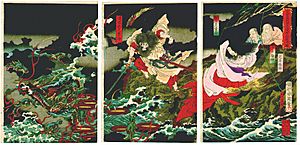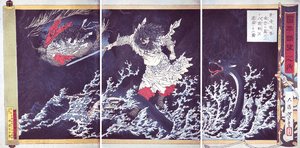Yamata no Orochi facts for kids

The Yamata no Orochi, often just called Orochi, is a famous eight-headed and eight-tailed Japanese dragon or serpent from ancient Japanese stories. It is a powerful and scary creature in Japanese mythology.
Contents
The Legend of Yamata no Orochi

The stories of Yamata no Orochi are found in two very old Japanese books. These books are the Kojiki (written in 680 AD) and the Nihon Shoki (written in 720 AD). Both books tell a similar tale about the powerful storm god, Susanoo.
Susanoo's Journey and a Sad Family
In the myth, Susanoo, a Shinto god, was sent away from Heaven. This happened because he played a trick on his sister, Amaterasu, who is the sun goddess. After leaving Heaven, Susanoo came down to Earth. He landed near the Hi River in a place called Izumo.
There, he met an old man and an old woman. They were crying with their young daughter, named Kushinadahime. Susanoo asked them why they were so sad. The old man explained that they had eight daughters. But a terrible eight-headed serpent, the Orochi, had eaten one daughter every year for seven years. Now, it was time for the Orochi to come and take their last daughter, Kushinadahime.
Susanoo, feeling sorry for them, decided to help. He asked the old couple if they would let him marry their daughter if he saved her. They agreed, honored to have a god help them. To keep Kushinadahime safe, Susanoo magically turned her into a comb and put her in his hair.

The Clever Plan to Defeat Orochi
Susanoo then told the old couple his plan. He told them to make a special, strong sake (Japanese rice wine). He also instructed them to build a large fence around their house. In this fence, they needed to make eight gates. At each gate, they were to place a platform. On each platform, they should put a large vat filled with the strong sake.
The old couple followed Susanoo's instructions carefully. They waited for the monster to arrive. Just as they expected, the Yamata no Orochi appeared. It was a terrifying sight. Its eyes were red like winter cherries. Moss, fir trees, and cypress trees grew on its back. It was so long that it stretched over eight hills and eight valleys. Its belly was always bloody and inflamed.
The Orochi, with its eight heads, smelled the sake. Each head dipped into a different vat and drank the strong wine. Soon, the giant serpent became very drunk. All eight heads fell asleep.
The Great Battle and a Special Sword
This was Susanoo's chance! He pulled out his powerful sword. He began to cut the sleeping serpent into many pieces. The Hi River turned red with the Orochi's blood. As he was cutting the middle tail, his sword hit something hard and broke.
Curious, Susanoo poked the tail with the tip of his broken sword. Inside, he found a magnificent sword! This special sword was later named the Kusanagi-no-Tsurugi, which means "Grass-Cutting Sword." Susanoo thought this sword was very important. He sent it to his sister, Amaterasu, in Heaven.
The Kusanagi-no-Tsurugi became one of the three sacred treasures of Japan. These treasures are the Imperial Regalia of Japan. They include the Kusanagi sword, the Yata no Kagami mirror, and the Yasakani no Magatama jewel.
What Does "Orochi" Mean?
The Japanese name orochi (大蛇) comes from an older Japanese word, woröti. The word Orochi means "big snake" or "large serpent." Some people think the "o" part might come from the word for "tail" (o) or "big" (ō). The "-chi" part might mean "god" or "spirit," similar to the word for river dragons, mizuchi.
Dragons and Heroes Around the World
Stories about multi-headed animals are rare in real life, but they are very common in myths and legends. Many cultures have tales about heroes fighting multi-headed dragons or serpents, just like Susanoo fought the Yamata no Orochi.
Multi-Headed Creatures
The Yamata no Orochi had eight heads. Other famous multi-headed creatures in myths include:
- The 9-headed Lernaean Hydra from Greek mythology, which was defeated by Heracles.
- The 100-headed Ladon, also from Greek myths.
- In Japanese Buddhist stories, there is Kuzuryū (九頭龍), the "9-headed dragon."
Heroes Fighting Monsters
The idea of a hero fighting a giant monster or dragon is a very old and popular story around the world. These stories often show a fight between order and chaos. Here are some examples:
- Thor fighting Jörmungandr in Norse mythology.
- Zeus fighting Typhon in Greek mythology.
- Indra fighting Vritra in Indian myths.
- Saint George fighting the Dragon in Christian mythology.
- Marduk fighting Tiamat in Babylonian myths.
- Ra fighting Apep in Egyptian myths.
These stories show how people in different parts of the world have similar ideas about brave heroes facing huge challenges.
See also
 In Spanish: Yamata-no-Orochi para niños
In Spanish: Yamata-no-Orochi para niños

